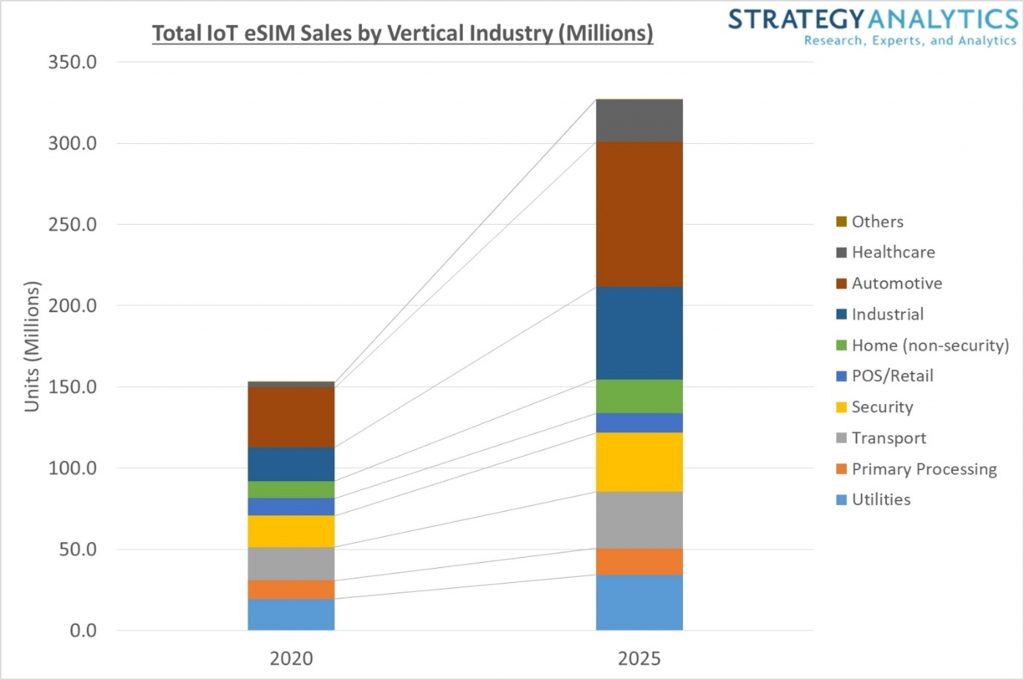What Does eSIM Mean for IoT?
An overview of the eSIM including eSIM definition, benefits for IoT and eSIM adoption.
What Is eSIM?
eSIM, eUICC and MFF2– are often talked about interchangeably, even though there is a fairly large difference: The eUICC, embedded universal integrated circuit card, is the embedded software component that allows the remote SIM provisioning of multiple network profiles. According to GSMA, eSIM is another word for eUICC. The MFF2 SIM is the hardware component of the SIM and a physical form that can be soldered into a solution.
eSIM stands for Embedded Subscriber Identity Module. The eSIM – embedded SIM – is a SIM where the subscriber profile can be changed over the air without changing the actual SIM. MFF2 SIM is an alternative to the traditional plastic SIM card which is embedded into the electronics in an IoT device. Using a MFF2 SIM for an IoT SIM card has several advantages including enabling the SIM to be installed at the factory, rather than at the point of deployment. Using an eSIM has other advantages such as possibilities to create truly global products with a single stock-keeping unit (SKU), with the eSIM updated over-the-air when it is deployed.
To delve into the vast spectrum of IoT technologies and their game-changing applications, including 5G, LTE-M, and more, visit our comprehensive page about IoT Technology.
How Does eSIM Work?
eSIM supports over-the-air provisioning of an initial operator subscription and the subsequent change of subscription from one operator to another in accordance with the GSMA Embedded SIM specification. Use of the GSMA Embedded SIM specification simplifies industrial and logistic processes for the distribution of M2M equipment.
Historically, SIM cards could hold just one subscriber identity linked to a single service provider. One service provider can still provide access to several networks through roaming, but in order to switch service providers, the SIM card needed to be physically changed to a new SIM card with a different subscriber identity. Physically exchanging SIM cards creates complexity for companies managing large fleets of devices, especially for international deployments, or if the SIM card is not easily accessible.
Another example of inefficiency was present when a business wanted to switch service providers when the existing contract expires. This might become costly, depending on how easy it is to physically access the SIM card in the already deployed fleet of machines.
Key eSIM IoT benefits include:
- Simplified installation and deployment
- Flexibility
- Future-proofing
- Cost-efficiency
- Security
eSIM Adoption in IoT

Strategy Analytics forecasts that sales of eSIMs for IoT applications will grow to 326 million by 2025. One of the reasons for this projection is that eSIM offers the ability to change service provider profiles using remote SIM provisioning (RSP), without needing to physically change the SIM card itself, which is vital in enabling devices where it is either difficult or inefficient to access a physical SIM, for example hermetically sealed medical devices, vehicles, consumer electronic devices or a whole range of other IoT devices.
Telenor Connexion fully supports eUICC deployments, taking care of the commercial, technical and operational complexities related to the eUICC technology. We offer our customers a full stack IoT services, from hardware to managed connectivity services and data cloud management to software and app development. The eUICC technology is integrated in this stack of IoT managed services.

